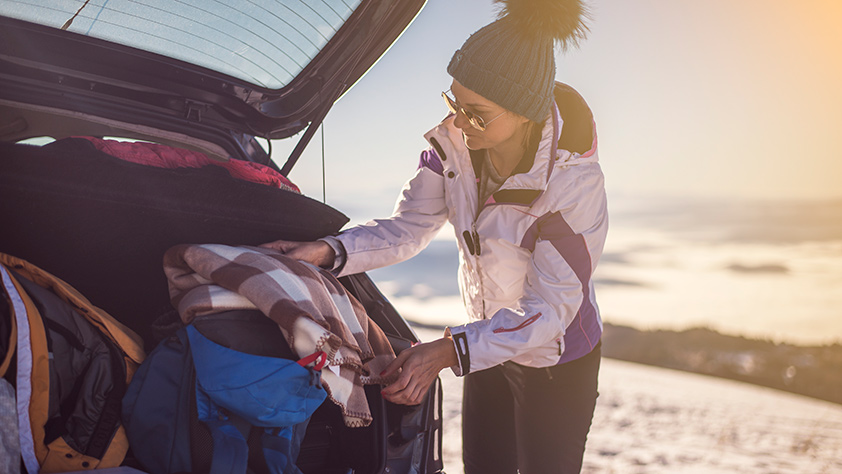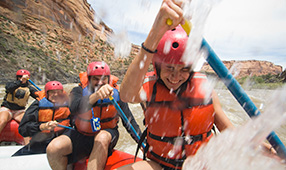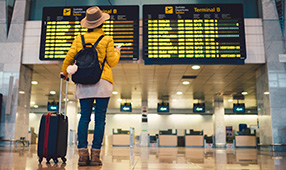Winter is a fantastic time to explore new destinations, even if you aren’t a die-hard skier or snowboarder. Go wildlife watching (animals are easier to see in the winter), learn to snowshoe or take a photo hike for a new outlook on the season.
However, traipsing around in a frozen wonderland is pure misery if you’re shivering from the cold. And who likes numb hands or toes? Staying warm on a winter trip is definitely a challenge, especially with today’s airline baggage weight limits. But it can be done. Forget the heavy sweaters, jeans and fancy ski pants or jackets. Follow these six tips to pack what you really need to stay toasty without spending a fortune.
1. How many layers should I pack?
Did you know that there’s real science behind layering clothes to stay warm? Wearing layers traps air, which is warmed by your body heat. As long as the air stays trapped, you stay warmer. And several thin layers trap more heat than one or two really thick layers.
Begin with an upper and lower body base layer made of merino wool, silk or synthetic fabrics such as nylon or polyester. These materials maintain an air pocket between your skin and the cloth. That air stays warm while the fabric wicks away moisture (which can make you cold). A light- to mid-weight fabric will work fine unless you are headed for the coldest of climates where a heavyweight fabric is more appropriate.
Insider clothing hack
- Wear tights or pantyhose under your slacks to take advantage of the layering concept without buying anything new.
Depending on the weather, you may want to layer one base on top of another. A turtleneck (that isn’t cotton) works well for the upper body while lightweight convertible “safari pants” are an economical choice for the lower body. And since these are lightweight pieces of clothing, they’ll take up less room in your luggage.
Add a fleece jacket (a down or fleece vest is another option) for insulation and top it off with a rain jacket that’s water and windproof. Wearing rain pants will keep bottom layers dry. If you’re planning a downhill ski trip, consider a ski jacket and ski pants, instead. Make sure both the jacket and pants are breathable. That means any fabric that doesn’t trap moisture since it will evaporate on your skin and make you feel colder. Linen and lightweight cotton are both very breathable fabrics.
2. How do I keep my hands and feet warm?
For hands, glove liners topped off with a pair of thermal stretch gloves do the job. Feet will stay warm with sock liners and thick, merino wool hiking socks. Pack air-activated, TSA-approved toe and hand warmers to really keep toasty.
Rather than expensive snow boots, waterproof gaiters are an economical, as well as a space-saving choice. They fit around the lower portion of the leg and top of the shoe. Combine with a waterproof hiking shoe—or spray your current hiking shoes with a waterproofing spray—and you’re all set.
If you’re going to bring boots, wear them on the plane to save room in luggage. Or pack them in a rolling duffle bag that you check. Rolling duffle bags are a good choice for packing bulky or odd-sized items.
Insider clothing hacks
- Wear leg warmers instead of buying wool pants or ski pants; you can even make leg warmers from old sweaters.
- Use mitten clips on the bottom edge of your pant legs to make sure they don’t ride up and out of your boots.
- Buy a piece of wool, trace your foot and cut out makeshift insoles/warmers for your existing shoes.
3. What about my head?
Winter hats have a come a long way since the knitted version with a fringe topknot. Look for a knit hat with flaps for keeping ears warm. And a fleece neck gaiter, or balaclava, is convenient for pulling up over your ears and nose on windy days. It also keeps your neck cozy.
Insider clothing hack
- Layer a pair of ear warmers or an ear headband that you already own under your hat if you don’t want to buy a new heavy-duty chapeau.
4. What kind of sun protection do I need?
Winter snow combined with glaring sun equals skin damage. Bring your favorite SPF sunscreen and an SPF lip balm. If traveling with carry-on bags only, purchase sunscreen at your destination. And don’t forget sunglasses for eye protection.
5. What do I wear in the evenings?
Multipurpose clothing is the key to traveling light. Remember that fleece vest? Wear it to dinner with a turtleneck, scarf (for women) and jeans. Packing one sweater that goes with two pairs of jeans, such as black and gray, will take you through most nights of the trip. Add a pair of comfy sheepskin boots to complete the look.
6. Where do I find budget-friendly winter gear?
In northern parts of the U.S., big box stores like Costco carry plenty of winter gear supplies. You’ll probably find everything you need. And as an NEA member, you have access to the NEA Discount Marketplace shopping portal, where you can find discounts on brand-name items and earn cash back when you shop. When purchasing ski clothing or other specialty items, ask for advice at a local sporting goods store such REI so you can make well-informed choices.
Follow these tips on your next cold-weather trip and you’ll be armed with the right gear to help you enjoy the great outdoors—and you won’t risk going over your airline’s checked baggage limit.












